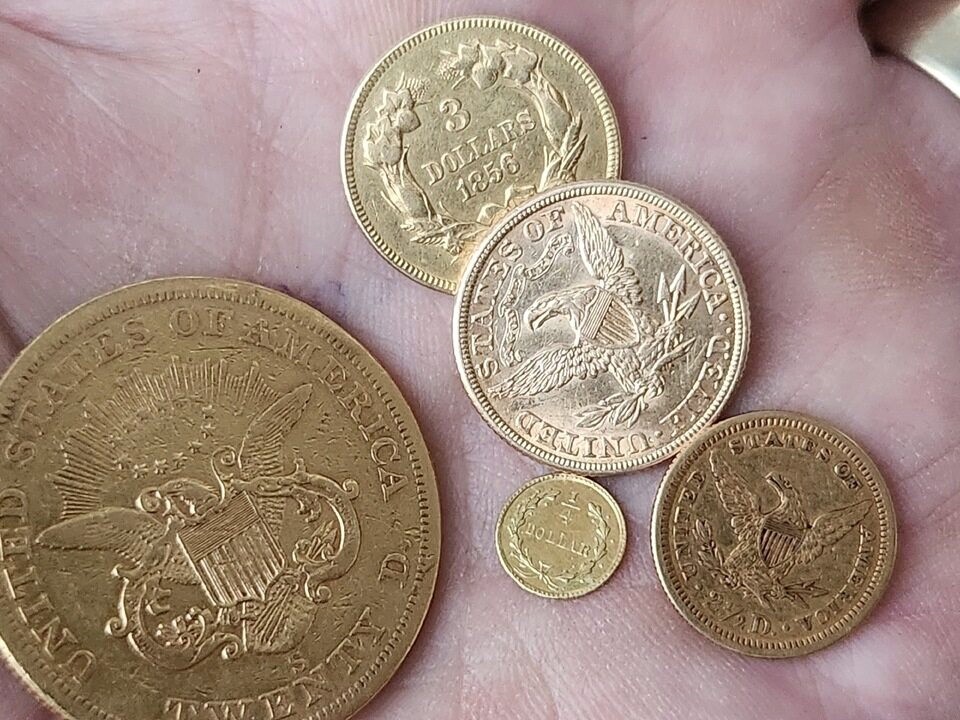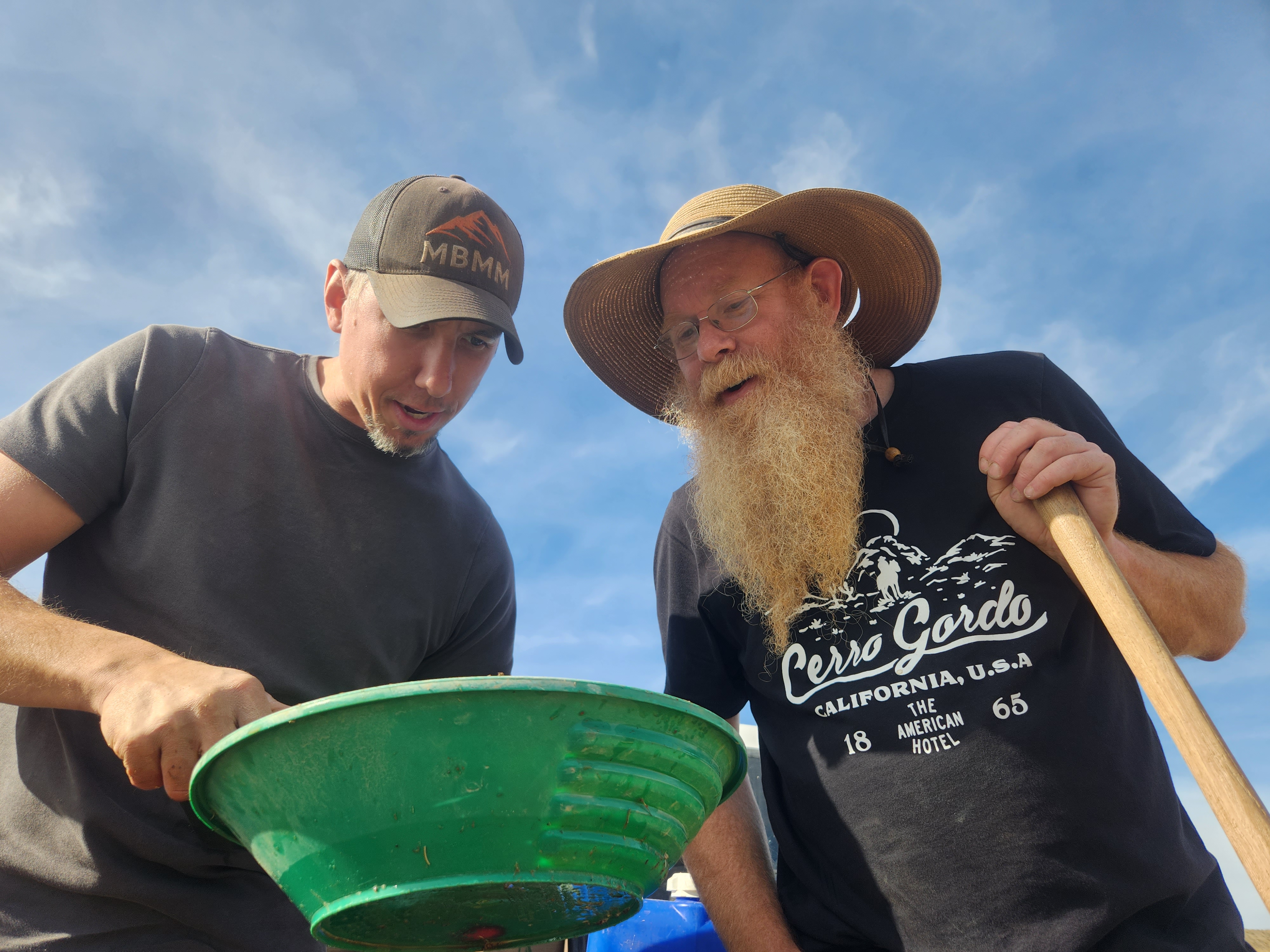Prospecting & Detecting
Twenty-Five Gold Indicators You Should Know
March 2014 by Chris Ralph
I frequently get asked, “What should I look for when I am out prospecting that will tell me there are good amounts of gold present in the ground?” I always respond, “I wish there was a simple answer to that question. It would make prospecting so much easier!”
The problem is that gold occurs in so many different types of deposits. The indicators to look for in one place for one type of deposit don’t always work very well for another. As an example, visible vein quartz on the ground is a valuable indicator in some locations, yet I have been to spots where there is so much vein quartz scattered everywhere that it becomes worthless when trying to pinpoint gold. On the other hand, I have been in other places that have good gold, but are essentially devoid of any visible vein quartz. There is no simple “one-size-fits-all” solution to what to look for in prospecting.
Still, while there is no one perfect answer, there are many useful indicators that prospectors can follow to lead them to gold. In this article, I am going to take a look at twenty-five different indicators that point toward the possibility of gold that you should keep in mind. Most of these indicators only work in certain places. No district has all 25 indicators, but knowing these indicators will help you become a better and more successful prospector. Once you have learned them, it will be your job to evaluate and decide which of these apply in the mining district in which you are prospecting. So, let’s take a look at each of these gold indicators and what they can tell you.
Signs of Past Placer Mining, and How to Use Them
One of the very best places to look for gold are the regions where the old-time miners were successful at finding it previously. They often left very obvious signs of their digging and mining, but at times these can become overgrown and hidden. They never got all of the gold, and perhaps most importantly, the old timers never had tools and equipment at all like we have today. Here are some man-made indicators of previous prospecting that you can look for in your quest for gold.
1) Ground cuts. These are basically the trenches in the ground from which ground sluicing gets its name. These narrow trenches carried the water and gravels to the sluice box, and sometimes they were the sluice boxes themselves. Sometimes gold that escaped the sluice box is left within these cuts.
2) Stacked rocks. In narrow and steep locations there was little room for the old miners to move the rocks away. The old timers were forced to stack the rocks into walls alongside the stream they were mining in order to get them out of the way. Sometimes unworked gravels lie underneath these stacked rock walls. Keep an eye 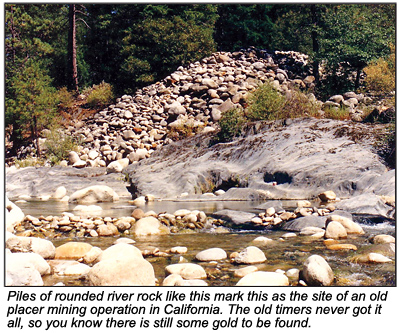 out for situations where these walls sit on gravel and not on the bedrock itself.
out for situations where these walls sit on gravel and not on the bedrock itself.
3) Piles of rocks. In many locations the gravels contain rocks that are too large to pass through the sluice. These big rocks and large cobbles are tossed into piles that can cover hundreds of acres. The bedrock between them can be very productive, and if they are not too large and deep, you will find that the bedrock underneath them is often productive. It is worthwhile to roll the rocks aside and check out what is underneath.
4) Areas stripped of their ground cover and top soils. These are often left behind as the mining operations processed these materials for their gold content. Sometimes tiny nuggets will get caught in the rough surface of the bedrock and this can be prime territory for metal detectors designed for nugget hunting.
5) Ponds and dams. Small-scale ground sluice operations and even larger hydraulic mining operations simply could not afford to bring water from long distances, so they built ponds close by to hold their water above the workings. When you find these, check for the placer workings nearby.
6) Dry wash (dry blow) piles. In the desert, where sluicing was not possible, dry washers were used to process the gravels. These leave distinctive piles of coarse and fine screened materials that are right next to each other. Dry washers are not as efficient as wet sluice operations, so check these piles for nuggets that were missed.
7) Potholes and shallow diggings. There are certain wind and water related processes that occur in desert environments that subtract light materials from the surface, leaving a concentration of heavy things like gold. They are worked with very shallow diggings.
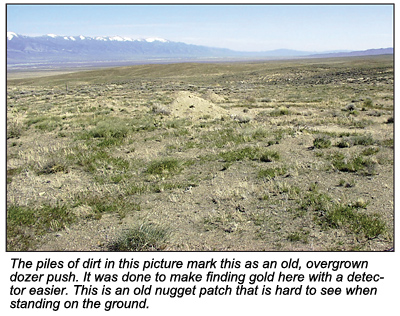 8) Deeper diggings, adits and shafts. Miners sometimes dug deep shafts, adits or other underground workings to access the concentrations of gold along bedrock buried beneath large amounts of overburden. Sometimes the spoil piles of these workings contain a decent amount of gold.
8) Deeper diggings, adits and shafts. Miners sometimes dug deep shafts, adits or other underground workings to access the concentrations of gold along bedrock buried beneath large amounts of overburden. Sometimes the spoil piles of these workings contain a decent amount of gold.
9) Hydraulic Mine Workings. When the old miners found large deposits of gravel, which had been left behind by the processes of erosion, if there was sufficient water nearby, they would dig trenches to bring it to the gravel and use the water pressure to wash the gravels away. 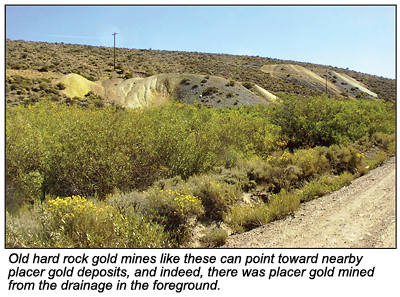 Check any exposed bedrock very thoroughly because they frequently missed narrow fissures and cracks that can hold nuggets. Exposed bedrock in and around old workings is always worth checking out. Sometimes it can be very productive, though not always.
Check any exposed bedrock very thoroughly because they frequently missed narrow fissures and cracks that can hold nuggets. Exposed bedrock in and around old workings is always worth checking out. Sometimes it can be very productive, though not always.
10) Dozer scrapes. Modern prospectors with metal detectors have learned to scrape off areas that are highly productive in order to access the layers of soil and gravel below, which their detectors can “see.” These scrapes leave visible clearings and piles of pushed material. Many are still worth detecting. I’ve taken nuggets as large as half an ounce out of other people’s scrapes. Areas adjoining to scrapes can be productive as well. Sometimes old dozer scrapes that have become overgrown can be spotted on satellite photos using Google Earth more easily than they can be seen on the ground.
Past Hard Rock Mining Signs Pointing Toward Gold,
and How to Use Them
Hard rock operations, of course, have an additional issue of dangerous old workings. I do not recommend going inside old underground mines. The dangers of these mines can be invisible to the eye. Bad air or areas devoid of oxygen can kill quickly before you even realize it. Old shafts can be covered over with wood that is now rotted and may cave in beneath your feet.
When looking in or around old mine workings, stay outside and be safe.
11) Mining Dumps. The underground excavations of mining operations nearly always leave coarse tailings piles on the surface. These tailings piles can actually contain quite a bit of gold. Many small miners could not afford to construct a mill, and so they had to sort their ore and ship only the highest grades to a custom milling facility. Oftentimes, visual sorting of the ore was not very efficient and they left good gold-bearing material behind. I know a number of prospectors who have done very well working with metal detectors on old mine dumps.
12) Open Stopes. A stope is a section of a mine where miners removed the vein material. They are often large areas in size, but they tell a prospector that the vein was rich enough to be worth extracting at this point. Sometimes these stopes come right to the surface and you will have a narrow working that may go along the 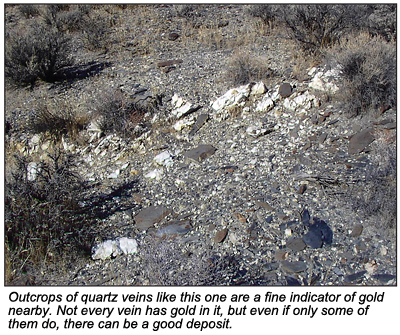 vein but be open for some distance down dip on the vein. Obviously these open stopes are quite dangerous, but often small workings or hillside slopes below these open stopes can be quite productive because the vein from this rich area shed bits of mineralized material downhill.
vein but be open for some distance down dip on the vein. Obviously these open stopes are quite dangerous, but often small workings or hillside slopes below these open stopes can be quite productive because the vein from this rich area shed bits of mineralized material downhill.
13) Mill Tailings. Mill tailings are the material that was crushed to a fine powder in order to extract the valuable minerals in the vein. Occasionally, when the mill was poorly operated, these mill tailings can contain very fine gold. This is not, however, the normal situation. Even if the tailings are not productive, their existence indicates the mine from which they came was productive and should have some interesting material in the dumps.
14) Sulfides or Iron Oxides in the Mine Dump. Many mine dumps have visible sulfide ore on their dumps. These sulfide ores can be rich in some districts and mark the better ores where you may find free gold closely associated with the sulfides.
15) Roads That Seem to Take Off to Nowhere. There are many times when I have used Google Earth to look for old mines that were not marked on maps or the information that was on the map did not sufficiently describe the location. Either out in the field or when looking at aerial photographs like those available on Google Earth, one can often follow faint old roads to their end and there will be the mine you are looking for. Not every old road leads to a mine even when the old road is in an old mining area—sometimes old roads lead to springs that were used by ranchers, etc. But it is an interesting and useful technique for finding obscure, old mines.
Nine Natural Geologic Signs Pointing Toward Gold
Here are some common geologic indicators that you can look for that will be helpful in many cases, but not in all.
16) Color Changes. In many districts, acidic mineral solutions have bleached the area rocks to a lighter color. Other color changes can be due to the contact of different types of rock. These color changes can be an indicator of gold because gold often occurs in altered rocks or along rock contacts.
17) Iron Staining & Gossans. Not all veins produce much quartz. Gold-bearing veins can consist of calcite or mostly sulfides—which often weather into iron-stained spots when the pyrites convert to iron oxides. Large amounts of iron oxides like hematite, magnetite and ironstone can be favorable indicators. Iron-stained ground areas and gossans are basically another sort of color change in the ground surface.
18) Quartz Vein Outcrops and Vein Matter Accumulations. At times, small accumulations of quartz vein material can indicate mineralization in the area. Sometimes there will be a visible vein outcrop that the prospector can see, but more likely the outcrop will not be obvious. In areas where there are no good outcrops, accumulations of quartz vein matter serve to indicate the general area where the vein is located. This is a very common indicator, but in many places a productive one that produces some good gold.
19) Productive Rock Types. The concept of favorable host rocks is an important one, but the types of rock that constitute “favorable” can vary a lot from one location to another and can be significantly different. Rocks that break into flat slabs like schist or slate are very common productive rock types in many gold placer districts, but in other places the productive rock type can be quite different. This is an important one to learn for each of the districts where you prospect.
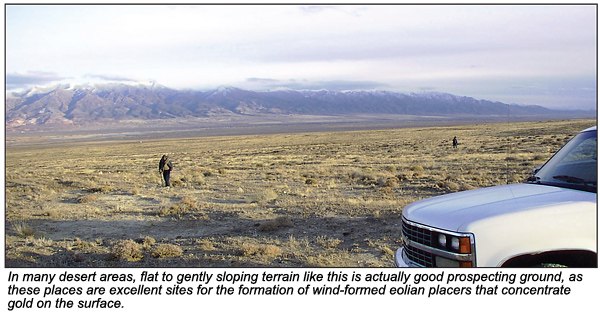
20) Rock Contact Zones and Faults. Many quartz veins and other hard rock gold deposits occur in “zones” that are formed along faults or at the contact of two different types of rock. This is another very productive type of indicator that has yielded a lot of gold to knowledgeable prospectors. These contacts may or may not show a color change across them, but even if the colors are the same on both sides, they can still be worthwhile.
21) Correct Topography. As a general concept, the coarser gold does tend to hang-up farther upstream. In the deserts, most of the best residual placers form in areas with moderate to flat slopes. Depending on what the characteristics of your gold-bearing district are—up high or out on the flats—you want to be in those areas with the most productive topography.
22) Extensions of Known Mineral or Placer Areas. Other than pipe-shaped bodies, most small-scale gold deposits have a linear component. It is fairly common that new deposits can be found along this linear zone of deposition by looking for extensions along the line of deposition.
23) Similar Geologic Areas Nearby. If a certain rock type or geologic environment has been productive for gold in one area, and the same rock type or environment occurs a few miles away in the same mountain range, it may well be worthwhile to investigate. This is a great technique for finding new patches and nugget areas, and a lot of prospectors have been very successful using it.
24) Desert Pavement with Quartz Vein Matter. In desert areas with shallow, wind-formed eolian placers, the best sign to recognize them is a concentration of small rocks and pebbles on the surface of the ground. In the Western US this formation is commonly called desert pavement. In gold-bearing regions when the desert pavement contains significant quartz vein material, this is a reliable sign that gold may also be present in the surface material.
25) Perched Gravel Benches Along Gold-bearing Streams. Rivers and streams wear down through the bedrock and can leave patches of gravel high and dry. These patches of gravel, if still in place, represent virgin material that can contain good gold. Often because they are elevated, the prospector can reach bedrock in these areas without having to dig down through a large amount of overburden. These benches are often very productive for prospectors.
Know Your District, Then
Get Out There and Explore
The man-made and geologic signs and indicators outlined above are useful and important for finding gold, but it’s important to remember that what works well in one district or location may not work so well in another. There is no single indicator of gold that works everywhere. In one place a certain type of rock may host all the deposits. In another district the most important indicator may be areas colored red by high iron concentrations.
Perhaps the most important thing in prospecting is to know the characteristics of the district that you are hunting! Like sports, there is a home court advantage for prospectors who have learned the particular tips and productive methods of the district in which they are working.
While I have addressed 25 different gold indicators that you should know, it’s important to remember that this is not an exhaustive list and there are plenty of other indicators that you might consider. However, these 25 are among the more common indicators of gold, and at least some of them will apply in almost all mining districts in both the US and abroad.
Learn to recognize and understand these indicators and then get out and explore new areas. Your mining equipment will not find any gold for you while it’s sitting in your closet or garage. One of the great secrets of successful prospectors is that they know what to look for and then get out into the field and work hard at searching. Get yourself out there and enjoy it to the fullest! 
Potential Gold at Old Hydraulic Sites
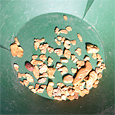 So why would a modern-day prospector want to learn about a method of mining that was banned by the courts more than a century ago?
So why would a modern-day prospector want to learn about a method of mining that was banned by the courts more than a century ago?
Crushing Quartz in Calaveras County: A Placer Miner Learns New Tricks
I had never run an impact mill before, but anything involving rocks, water and a big electric motor sounded great.
Hard Rock 101: Breaking Rock—Part I
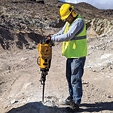 What do you do when you’ve located a promising deposit of gold or gemstones, but it’s trapped in solid rock?
What do you do when you’ve located a promising deposit of gold or gemstones, but it’s trapped in solid rock?
The World of the Simple Gold Pan
There are so many, many different types of gold pans on the market that I thought it would be worthwhile to take a look at the world of the simple gold pan.
High Sierra Gold
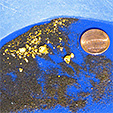 Join Cal on an adventure in the Califonria high Sierras!
Join Cal on an adventure in the Califonria high Sierras!
Subscription Required:
The Bawl Mill
• Ask the Experts
• Ask the Experts
• Ask the Experts
• Ask the Experts
• Prospecting Hard Rock
• Reese River Silver Mining District, Nevada
• Alaska: Large-Scale Mining Can Be Done Right
• Gold of the Iditarod Mining District, Alaska
• Bedrock
• Natural Gold Alloys
• Government Takes Land for Open Space
• Comments on Gold Rush and Bering Sea Gold Series
• Hidden Value in Old Tailings
• Melman on Gold & Silver
• Mining Stock Quotes and Mineral & Metal Prices


